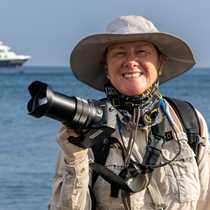The sun was up in full swing yesterday off the east coast of Santa Cruz Island, where we set out to explore the small yet ecologically vibrant island of South Plaza. Its northern equivalent sits just a couple hundred meters above and is separated by a strong Pacific current.
This is perhaps why the land iguanas, so famous on South Plaza, never managed their way onto the northern island.
It seemed that immediately upon landing, everything that was expected to be seen was found. In all my years of visiting this place, I do not recall seeing the prickly pear cacti so abundant in fruit. Every iguana we came across appeared fat and content—none of the wildlife seemed pressed for food.
Squabbling over nesting broke out between two females at one point. Soil is shallow here, and spaces with adequate depth can be difficult to find.
The swallow-tailed gulls were doing their nesting in every direction, some already attending to their young. As they are ground-nesters, one must take care walking around.
The sun went on climbing through the afternoon, which made for excellent swimming later in the day. One of the advantages of National Geographic Islander is the ease with which one can get into and out of the water from the loading platform. We took full advantage of it!
Right before lunch, Andres, our naturalist, gave an excellent presentation on Charles Darwin. The great scientist’s work takes on a whole new meaning when occupying the very grounds he once studied.
After lunch, we traveled south to Santa Fe Island, the only one throughout the entire archipelago with its own species of land iguana, Conolophus pallidus. We took an extended hike up along an escarpment and one shorter walk to a small forest of prickly pear cactus. We paired venturing on land with kayaking and paddleboarding in the fabulous blue bay. Days like this won’t pass from memory easily—and we are surely the better for it!







